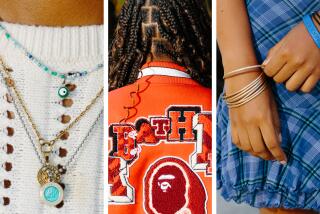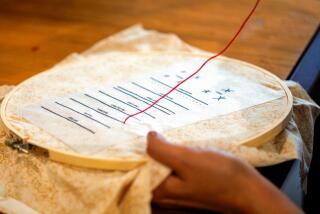Reforming Czech Wardrobe : Fashion: Young designers are eyeing new leader Vaclav Havel, with the idea of upgrading his--and the nation’s--style.
- Share via
PRAGUE — Czechoslovakia’s prominent playwright and Communist Party nemesis Vaclav Havel is settling into his new role as president of the country in which the once all-powerful Communists will become only one party among many.
But by some Czech’s standards at least, the short, 53-year-old leader’s wardrobe is remarkably unpresidential. Like most of his countrymen, Havel dresses in what might be described kindly as ordinary clothes: old brown or gray trousers stamped out of a generic, shapeless East Bloc style, an open-collared shirt and a black pullover sweater that looks as if he’s been wearing it for years.
As Havel has consolidated the country around him his message has not changed, but the shy playwright is beginning to give some attention to changing his dress in a way that might make him look a bit more like a head of state.
This started several weeks ago, when Havel noticed someone in his entourage wearing a black, Western-style parka. The playwright liked the jacket, tried it on, and asked how he might get one. The owner gave it to him and Havel has been wearing it ever since.
In fact, the parka was made by hand, by 24-year-old Viktor Koreis, one of a small group of fashion design students making Western-looking garments for Czechoslovaks who don’t want to look as if their wardrobes come out of a mail-order catalogue from the Comecon--the Eastern European trading bloc.
Koreis and other young designers have their eyes on Havel, who’s slowly getting used to appearing on national television wearing a suit and tie. In the months ahead they plan to supply him with a wardrobe of made-to-measure, Western-style suits.
Another fashion student, Marie-Helene Nunezova, 25, said the novice designers are determined that Czechoslovakia’s new political leaders will get used to wearing tailored suits of high quality material, a rare commodity in the Warsaw Pact.
“If these persons are our representatives,” she said, “we would like to help them be on the same level as the Western government leaders, who are always so well-dressed. It meant a lot,” she said, “when Mikhail Gorbachev and his wife Raisa were so well-dressed when they appeared in public. There was no way of telling from their clothes that they were from the East or the West.”
This effort to bring fashion to Czechoslovakia’s politicians and, eventually, to the people, is being largely orchestrated from the High School for Applied Arts, a university level school for painting, architecture, design and other artistic media. Like all other university buildings, this one, which overlooks the Moldau River not far from Prague’s historic Charles Bridge, was recently occupied by students determined to reform their school as well as their government. A poster showing a 1930s photograph of an elegant man in a tuxedo talking to two stylish women sets the tone. “Don’t be naive, my dear,” the caption reads, “the students aren’t finished yet.”
The ongoing work of the fashion studio takes place on the second floor. As Nunezova inspected the first of two large rooms, she apologized for the disarray of sleeping bags, half-written posters, and an improvised kitchen. “This is where some of us have been sleeping,” she said. “Students have been living here day and night.”
In the next room crowded with mannequins, sketch sheets, and rolls of fabric--where all the students of the department must share one working electric sewing machine--Nunezova explained why she thinks Czechoslovaks dress the way they do.
“In general, the people in Czechoslovakia are not dressed the same as people in the West,” she said, “because you can’t buy nice clothes in the ordinary shops since the factories aren’t producing such things. The factories here are making clothes according to old plans, which require them to do stupid things that nobody wants to buy. The people don’t have any other possibility to get clothes if they can’t bring them from the West, buy them for hard currency in special state shops, or sew the clothes themselves.”
By their own efforts, Nunezova and Koreis, who sat hunched over the sewing machine nearby, are already exceptions to this rule. Both are dressed in what at first glance looks like everyday casual European clothes--she in a short denim skirt and a light purple denim jacket with the label Mustang sewn on one pocket; he in faded blue jeans, a faded black denim jacket and a beige quilted parka inside which the label Western Wear can be seen. These garments were not brought back from a trip to the West, however. They are ready-to-wear knockoffs, hand made by the students themselves.
For years, Nunezova said, Czechoslovaks who wanted to look stylish but lacked access either to the West or to Western currency simply sewed their own wardrobes. They used patterns or actual garments they’d take apart and copy. The careful exactitude of the buttons and stitching of Nunezova’s and Koreis’ clothes show just how adept the independent tailors have become.
As a result, Nunezova said, many people in Prague--the capital and probably the country’s most stylish city--are accustomed to having clothes made privately to their own specifications. Thus while other artists have emigrated over the last 20 years, the demand for good clothing has supported a small group of fashion designers and kept them in the country.
Koreis said there is also a somewhat defiant political aspect to the students’ interest in looking as well-dressed as their Western counterparts. In the ‘70s, he explained, the Communists derided fashion as a bourgeois vice. “It was forbidden to wear jeans to school, to wear T-shirts with any kind of writing, and to have Western labels on the outside of your clothes, (in) the same way they prohibited long hair and elaborate makeup as dangerous Western influences which were bad for socialist morals.”
Beyond dressing their leaders, Czechoslovak designers have greater ambitions--including the creation of “revolutionary clothes” inspired by the dramatic political events of the last month, Nunezova said. These designs will probably incorporate red, white and blue, the colors of the country’s flag. “I think they should follow trends in international fashion,” she said, but “also draw on aspects of our traditional dress, on details from our national costumes.”
While Applied Arts students expect strong support from consumers, especially women, for freeing Czech fashion, they foresee obstacles to production in Czechoslovakia, where factories have been stamping out the same dresses for 40 years. Factories established according to Communist production structures, the students say, don’t adjust to new demands every six months as styles change.
“In the short term, the supply of cloth is likely to be our biggest problem,” said Zdenka Bauerova, a seamstress who has taught fashion design at the High School for Applied Arts since 1970. Bauerova supports the students’ efforts to reform Czech fashion. “We have a lot of people here who are able to create their own designs without depending on ideas from outside,” she explained. “The problem for us is to get materials of the same quality they have in the West.”
All this could change if, as expected, Western European capital starts to flow into Czechoslovakia. With factory wages far lower than in the West, and a modern transportation system, Prague is ideally placed to become a production center for both Eastern and Western European markets. A bonus: the city’s baroque architecture makes an excellent backdrop for fashion photography.
“Our biggest task, now,” said the student who made Vaclav Havel’s parka, “is to dress the Czech people like a normal nation, and to catch up with the Western countries after being cut off from them and living differently for more than 40 years. We have to work much harder than other countries if we don’t want to look like people from a hundred years before the monkeys.”
More to Read
Sign up for Essential California
The most important California stories and recommendations in your inbox every morning.
You may occasionally receive promotional content from the Los Angeles Times.













